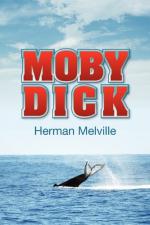Book III. (Duodecimo), chapter II. (Algerine Porpoise).—A pirate. Very savage. He is only found, I think, in the Pacific. He is somewhat larger than the Huzza Porpoise, but much of the same general make. Provoke him, and he will buckle to a shark. I have lowered for him many times, but never yet saw him captured.
Book III. (Duodecimo), chapter III. (Mealy-mouthed Porpoise).—The largest kind of Porpoise; and only found in the Pacific, so far as it is known. The only English name, by which he has hitherto been designated, is that of the fisher—Right-Whale Porpoise, from the circumstance that he is chiefly found in the vicinity of that Folio. In shape, he differs in some degree from the Huzza Porpoise, being of a less rotund and jolly girth; indeed, he is of quite a neat and gentleman-like figure. He has no fins on his back (most other porpoises have), he has a lovely tail, and sentimental Indian eyes of a hazel hue. But his mealy-mouth spoils all. Though his entire back down to his side fins is of a deep sable, yet a boundary line, distinct as the mark in a ship’s hull, called the “bright waist,” that line streaks him from stem to stern, with two separate colors, black above and white below. The white comprises part of his head, and the whole of his mouth, which makes him look as if he had just escaped from a felonious visit to a meal-bag. A most mean and mealy aspect! His oil is much like that of the common porpoise.
Beyond the duodecimo, this system does not proceed, inasmuch as the Porpoise is the smallest of the whales. Above, you have all the Leviathans of note. But there are a rabble of uncertain, fugitive, half-fabulous whales, which, as an American whaleman, I know by reputation, but not personally. I shall enumerate them by their fore-castle appellations; for possibly such a list may be valuable to future investigators, who may complete what I have here but begun. If any of the following whales, shall hereafter be caught and marked, then he can readily be incorporated into this System, according to his Folio, Octavo, or Duodecimo magnitude:— The Bottle-Nose Whale; the Junk Whale; the Pudding-Headed Whale; the Cape Whale; the Leading Whale; the Cannon Whale; the Scragg Whale; the Coppered Whale; the Elephant Whale; the Iceberg Whale; the Quog Whale; the Blue Whale; &c. From Icelandic, Dutch, and old English authorities, there might be quoted other lists of uncertain whales, blessed with all manner of uncouth names. But I omit them as altogether obsolete; and can hardly help suspecting them for mere sounds, full of Leviathanism, but signifying nothing.
Finally: It was stated at the outset, that this system would not be here, and at once, perfected. You cannot but plainly see that I have kept my word. But I now leave my cetological System standing thus unfinished, even as the great Cathedral of Cologne was left, with the cranes still standing upon the top of the uncompleted tower. For small erections may be finished by their first architects; grand ones, true ones, ever leave the copestone to posterity. God keep me from ever completing anything. This whole book is but a draught—nay, but the draught of a draught. Oh, Time, Strength, Cash, and Patience!




